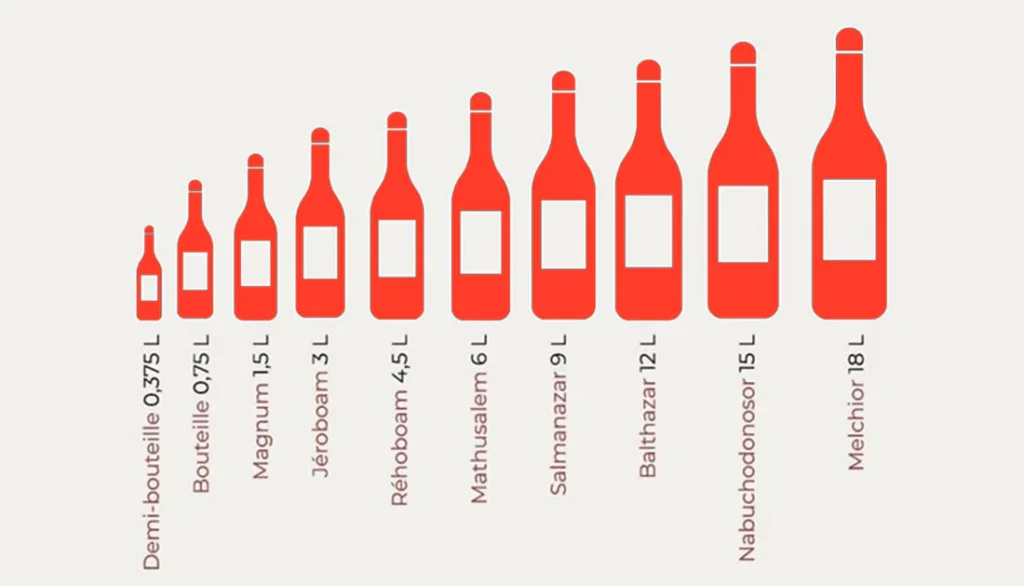As wine enthusiasts know, some bottles do more than just please the palate. They also become investment objects. Among them, large-format wine bottles are increasingly attracting collectors. But are they really more profitable on resale? Let's find out.
If you're interested in wine-related articles, download our app for IOS or Android. It will give you access to our wine lexicon, our articles and our innovative solution, designed for all wine consumers and collectors.
An imposing presence, greater potential
Size matters, especially when it comes to wine. A magnum bottle, containing 1.5 liters, is equivalent to two conventional bottles. Some sizes even exceed 3 or 6 liters. These prestigious containers are attractive for both aesthetic and technical reasons.
Large-format wine ages more slowly. Thanks to a lower air/wine ratio, oxidation slows down. As a result, aromas are better preserved. As a result, these bottles remain attractive for longer. This factor plays a key role in their long-term investment.
Figures confirm the trend
The market confirms this appeal. At auctions, large formats often generate significant price increases. Some Balthazar (12-liter) and Imperial (6-liter) bottles have doubled or tripled in value, compared with the standard version.
The scarcity effect also comes into play. Estates produce these formats in limited quantities. This reinforces their collectability. Buyers are looking for the exceptional, and large formats meet this criterion with flying colors.
A specific but loyal audience
Large-format enthusiasts form a targeted audience. They appreciate prestige as much as investment. At large-scale dinners or prestigious events, a magnum bottle impresses. It becomes the centerpiece of the evening.
Hotel and restaurant professionals are also fond of these formats. They add value to their cellars and build customer loyalty. This generates stable demand, a positive factor for the profitability of large-format wine.
Logistics costs to take into account
However, this enthusiasm needs to be tempered. Large formats require specific logistics. Storage requires more space. Transport costs more. We also need to provide suitable supports for display and storage.
Insurance costs can also rise. Some companies charge higher premiums to cover rare formats. These costs reduce the net margin on resale. So it's crucial to anticipate these costs from the outset.
A diversification asset
Wine investment isn't just about standard bottles. Diversifying with a few magnum bottles can balance a portfolio. These formats offer interesting stability, especially during periods of fluctuation.
What's more, large-format vintages hold their value longer. This makes it possible to plan a later resale, often at a better price. This flexibility offers valuable leverage for seasoned investors.
The role of specialized platforms
Several websites now offer services dedicated to large-format wine bottles. They provide authentication, appraisal and sales support. This type of support reduces the risks associated with resale. It also facilitates access to an international audience.
Some high-end platforms even offer thematic auctions. These place a premium on rare formats. They guarantee higher sale prices for wine investors.
Choosing the right wine, the right format

Not all wines lend themselves to this type of investment. You need to target well-known estates with sought-after vintages. A magnum of classified Bordeaux or a grand cru bourguignon retains its value better than a large-format table wine.
The ideal format also depends on the objective. For short-term resale, a double magnum is easier to handle. For the long term, prefer an imperial or a jeroboam. These rare formats benefit from an enhanced rarity effect.
When to resell to maximize value?
Wine collection profitability also depends on good timing. You have to follow trends and watch out for events (centenaries, new vintage releases). These occasions trigger peaks in demand.
Keeping a bottle for 10 to 15 years can multiply its purchase price. But be careful with storage. The wrong temperature can ruin a wine, even in a large format. Hence the importance of a well-managed cellar.
Case studies: examples of profitability
A magnum of Romanée-Conti 2002, bought for €2,000, sold for over €9,000 ten years later. A Château Lafite Rothschild jeroboam recently sold for over €20,000. These examples confirm the appeal of large formats on the market.
Of course, these gains are not systematic. They depend on many factors: state of preservation, reputation of the vintage, quality of the cuvée. Investment is therefore reserved for connoisseurs or those with sound advice.
Integrating large formats into a private cellar
For amateurs, adding a few large-format bottles to the cellar is a way of reconciling passion and strategy. You need to provide suitable racks and check temperature and humidity conditions.
Some wine lovers buy en primeur, as soon as the wines come on the market. This allows them to benefit from more attractive prices. Resale a few years later generates appreciable added value, if the wine is well preserved.
A fast-growing market
The collectible wine sector is evolving. Young investors are taking an interest. Magnum and larger formats are attracting attention. Their rarity and aesthetic appeal are also attracting an international clientele in search of unique products.
This phenomenon benefits producers. They focus on large-format, limited editions, often with vintages. This creates a sense of expectation and scarcity, which feeds the investment dynamic.
If you enjoyed this article, please read the following one "Wine market indices: how to read them"which may also be of interest to you!





